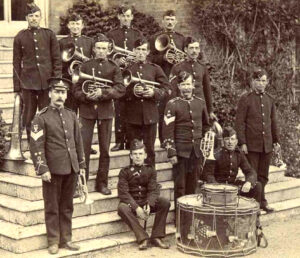 Padstow Volunteer Band 1908
Padstow Volunteer Band 1908
Back row: Percy Courtenay, Albert Hill, Tommy Tresidder, Jim Parsons.
Second row: Albert Courtenay, Tom Williams, Tom Trenouth.
Front row: Edgar Tonkin, Ewart Worsley (sitting) Alfred Buckingham, William Courtenay (sitting) S Veal.
The Volunteer forces of the mid to late 1800s were an important part of the defence of this nation when our professional forces were often deployed overseas. Many towns across Cornwall played host to them and their bands often played at local events and took part in brass band contests. John Buckingham of Padstow Old Cornwall Society brings us the story on one such group centred on Padstow. He follows this with the exploits of his father, Maurice John Buckingham, who was a member of the 134th (Cornwall) Heavy Battery Royal Garrison Artillery.
It was in 1859 when the men of Padstow answered the call to arms to help protect the coast of Cornwall from the threat of invasion from across the Channel. They would be the first in Cornwall.
Artillery batteries were formed in Padstow (1st) on 27th September 1859, Looe (2nd) 17th October, Fowey (3rd) 25th November, Charlestown (4th). The fifth and sixth were at Par and Par Harbour and were later amalgamated. The seventh, at Polruan, formed in February 1860 and the eighth, at Hayle, in April. The ninth was solely of miners at Fowey Consuls and lasted until 1863. The tenth corp was formed at Buryan in November 1860, moving to Newlyn in 1868 and Penzance in 1877. The eleventh corp was at St Ives in November 1850, disbanded in 1878. The twelfth formed at Marazion in April 1861 and the thirteenth at St Just in September 1862.
In 1880, there were several adjustments to the corp numbering including the omission of No. 13. The headquarters were originally in Bodmin but moved to Falmouth in 1888. In 1908, the corp became The Cornwall (Duke of Cornwall’s) Royal Garrison Artillery.
In the early years, the uniform consisted of a long knitted blue jersey of fisherman’s pattern, the collar cuffs and bottom edge being banded in red. On the front, embroidered in red wool, was C.V.A. (Cornwall Volunteer Artillery) over the corp number. (in the case of Padstow this was number one) with the familiar 15 bezants of the Duke of Cornwall and the motto One and All. Most recruits bought their own uniforms at a cost of £2: in 1872 a more regular Artillery pattern was introduced.
The maximum establishment in Cornwall varied from 880 in 1870 to 1,040 in 1907. The Padstow Battery, in 1859, was led by Squire Charles Glynn Prideaux-Brune supported by John Tredwen, the ship builder, and Hender Pearse, a farmer of Treator Farm. Shipwrights, farm workers, clerks and many other trades joined the corp.
We are lucky here in Padstow Museum, thanks to Geraldine Tutton, to have a copy of the Muster Roll from 1859 to 1908. Her grandfather, Sergeant George, had kept the original from his time with the DCLI (T A) in Padstow.
Captain Milne, in the only book written on the 1st Cornwall (Duke of Cornwall’s) Artillery Volunteers in 1885, tells us:
The first Company of Artillery Volunteers in the county was raised at Padstow (owing mainly to the exhortations of Charles Prideaux-Brune Esq of Prideaux Place) the date of acceptance of service being 12th September 1859. Considering the size of the town, and its somewhat remote situation it is particularly creditable to the inhabitants that they should be the first to offer their services in the defence of their native shores. The maximum establishment is fixed at 80, this included three officers.
In July 1860, a large detachment went to Plymouth to fire a royal salute from Mount Edgcumbe on the occasion of the departure of the Prince of Wales for Canada in the Royal Yacht.
In 1862, when HMS Vivid anchored in Padstow harbour with Prince Arthur on board, they fired a royal salute.
Some indication of the spirit that existed can be read from a report made in 1869 of an inspection made at Par. Captain Tredwen was in command with Lieutenant Seaton, five sergeants, 59 rank-and-file, and the band.
The steadiness of the Padstow Battery deserved special mention for the manner in which they marched, called forth praise from both the inspecting officer and the other volunteers. A military man on the ground stated that he considered them equal to even the Royal Artillery, and that they were as firm as a rock.
Praise indeed.
In 1871, after the premature death of John Tredwen, and the temporary closure of the higher yard, numbers in the battery declined and a detachment was formed at St Issey with their own gun and drill hall. Padstow continued to use the drill hall at the bottom of Horsemill (now St Edmunds) Lane. The centre of activity was the gun emplacement at Gun Point with commanding views out over the estuary. The remains can still be seen today with additions made during the Second World War.
An important part of the corp in Padstow was the band: it was a feature of parades and events in the town. Grandfather Buckingham was a prominent member, as several group photographs testify.
News reports give a flavour of the corp’s activities:
In June 1886 they attended church under Captain W H Martyn and Lt. W S Allport. There were four sergeants, two trumpeters and 45 rank-and-file. The band, under T Pascoe, was in attendance.
In 1893, there was an inspection by Colonel Palby and Colonel Gilbert. The corp, led by Major Allport and Lieutenant P Griffin, was made up of one sergeant major, one quarter master, three sergeants, one drill instructor and 63 rank-and-file. The band was also in attendance. There was a gun practice of 2,400-yard range. The annual supper at Lobb’s Commercial Hotel was attended by Captain Norton, Captain Nilsen, Captain Rawle, Messrs. J P Tom and T V Henwood. After dinner, songs were sung by Captain Thornton, Lieutenant Griffin, Sergeant Chapman, H Biddick and Biscomb. Captain Nilsen, T V Henwood, Bombadiers T Q Pascoe and S Sleeman, Gunners F Biddick, A Buckingham and T H Apps.
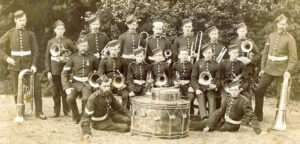 Padstow Volunteer Band 1907 (Photo: John Buckingham)
Padstow Volunteer Band 1907 (Photo: John Buckingham)
Back row: H Apps, F Sluman, Alf Buckingham, Joe Buckingham, Edgar Tonkin, Sid Tonkin, Alf Langford, Stanley Veale, Sidney Sleeman
Sitting: John Buckingham, Willie Veale, George Buckingham, T Chellew, Tom Langford, Harvey Lobb, Willie Lobb Sitting on ground: Joe Williams, Albert Courtenay
The corp and band continued to play an important part in the life of the town with many familiar names being added to the muster roll. As well as my Buckingham and Hornabrook ancestors there are many other family names: Curgenven, Brewer, Ellery, Henwood, England, Chapman, Williams, Trevethan, May, Gool, Martyn, O’Hagan, Oldham, Rabey, Reynold and many more.
The sons and grandsons of the founding members were by now, joining the ranks. The list runs out in 1908, at the time the Volunteers were renamed the Cornwall Royal Garrison Artillery to bring it in line with the national reorganisation. The Terriers (the T A) were now training in earnest and postcards show them at Staddon Heights near Plymouth (1910) and Trawsfynodd in Wales (1914). There is an air of the great adventure about these pictures. Little did they know what was in store for them in the near future. Gunners Edward Joseph Bruford, Richard George Dale, William Richard Dale, John Edyvean and Arthur Oswald Slawson all lost their lives: others joined infantry battalions. Those that returned got on with their peace time jobs in shops and on the land. For many, it was a time to settle down, get married and start a family. They did not know that many of them would be in uniform again so soon. The Home Guard, Fire Service, Police, ARP Wardens and Red Cross were all recruited from the men and women who had seen service in The War to End All Wars.
A Padstow Man at War
 Fred Hammett, Major Bennett Williams, Alfie Willcocks, Maurice Buckingham, Bugler Steve Hammett in camp at North Wales 1914
Fred Hammett, Major Bennett Williams, Alfie Willcocks, Maurice Buckingham, Bugler Steve Hammett in camp at North Wales 1914
 Maurice John Buckingham Cornwall Royal Garrison Artillery T A 1916
Maurice John Buckingham Cornwall Royal Garrison Artillery T A 1916
 134th (Cornwall) Heavy Battery Royal Garrison Artillery. (Photo: Courtesy of Claire Leith, Major Oats’ daughter)
134th (Cornwall) Heavy Battery Royal Garrison Artillery. (Photo: Courtesy of Claire Leith, Major Oats’ daughter)
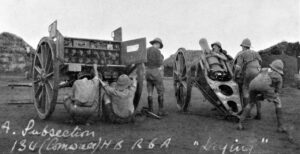 134th (Cornwall) Heavy Battery RGA. (Photo: Courtesy of Claire Leith, Major Oats’ daughter)
134th (Cornwall) Heavy Battery RGA. (Photo: Courtesy of Claire Leith, Major Oats’ daughter)
 134th (Cornwall) Heavy Battery RGA. (Photo: Courtesy of Claire Leith, Major Oats’ daughter)
134th (Cornwall) Heavy Battery RGA. (Photo: Courtesy of Claire Leith, Major Oats’ daughter)
In February 1916, a young 20-year-old Padstow lad found himself in a distant land… near Dar es Salaam in East Africa, part of a force attempting to remove the Germans from what is now Kenya and Tanzania. He was part of the 134th Heavy Battery RGA (Cornwall), drawn from Volunteer Batteries based around our coast. Padstow, St Just and Charlestown were among those represented. The 134th Battery RGA T A consisted of Cornishmen under Major Oats from St Just and Bennett Williams from Trevone.
Not long after he arrived he wrote in his diary, “Took a stroll in the bush, saw wild boar, leopard and plenty of buck”. I imagine him reading his mail beneath a canvas stretched between trees, one letter from brother Charlie (serving with the DCLI in France), two from Southampton and one from Poplar. There would have been the usual parades and Guard duties.
One of his favourite stories involved one of the St Just men who went for a stroll in the bush and came back somewhat disheveled. Asked what happened, he replied in his best West Cornish, “I valled over the ‘edge and stanked among the merrians”. Swahili was sometimes easier to understand!
When not in action there would be socialising among the many troops in the camp. Indians and South Africans were billeted nearby. My father’s diary entry often just said, “Had a good time”.
A much more descriptive diary was written by Richard Lewis Elliott and shared with me by Peter Smith, the researcher who provided the profiles of all those who appear on the Padstow War Memorial and the one in the Parish Church. It is available on line at the Padstow Museum website. You will find Edward Joseph Bruford there. He died from Malaria and was buried in Dar es Salaam Cemetery. Lewis, who it would seem was doing a similar job to my father, but a little later, at the end of the campaign writes:
“My lucky day here. I had crawled through long grass, with my phone and reel of wire and range finder. Enemy firing was rather heavy here but by good fortune I was able to direct our battery fire on those machine gun nests and destroy the lot, thus enabling the infantry to advance and capture the bridge into Portuguese territory. This was the end of the war for them. One of my best friends, Dick Pooley, who came from Penzance, was killed in this action. I have pieces of parchment signed by Winston Churchill (mentioned in dispatches) for this work. I was very scared at the time as I thought my number was up but managed to get through. We lost a number of people here (fever and dysentery killed many).”
He also gives a statistic on leaving for home. Only 50 remain of the Battery out of the 185 that began.
The 2nd Battalion of the Loyal North Lancs had been involved from the beginning, along with several Indian units. They summed up the situation well: “Far more deadly than the Germans were the diseases that laid low and even killed so many. Malaria became endemic as did Beriberi and Black Water Fever. Wild carnivores, charging elephants and rhinoceros lurked in the thick bush.”
Many of the regiment would never see home again.
In May, the 134th were on the move, rations were short and the men were restricted to three biscuits a day. Despite that, heavy guns had to be moved, often with no roads to speak of, and rivers to cross (did I mention crocodiles?) it was slow, laborious progress.
Names we have become familiar with on wildlife TV programmes like Serengetti, Morogorro and Mount Kilimanjaro appear in my father’s diary entries. There was always the enemy just over the hill, making their progress more and more difficult. There were successes but the enemy were always moving, just out of reach.
By August, our Padstow soldier was getting repeated bouts of fever and like so many others, was finally sent to Capetown in South Africa for repatriation. He was no longer fit for duty and was honorably discharged the following year.
It is worth noting that nearly 400,000 people were involved in this conflict. British losses were 3,443 killed in action and 6,558 died of disease. Many of these were from the Indian sub-continent but at least seven of our Cornish Artillery Volunteers lie in East African graves. Nothing, of course, compared to the numbers of African porters who lost their lives – out of 600,000 men, 95,000 were reported to have died in the service of the Empire.
The Reunion
In 1954 a reunion was held at Penzance but unfortunately, my father did not attend.
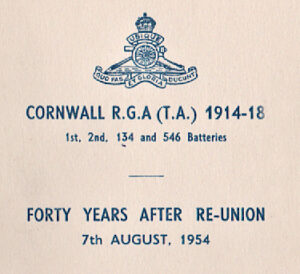
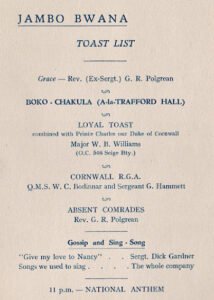
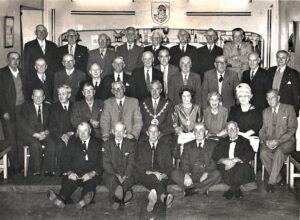 At the 1954 T A Reunion
At the 1954 T A Reunion
We have no names for these grand old soldiers – perhaps they are included in a newspaper report on the event.
Sources:
The Diary of Gunner Maurice John Buckingham. (1896-1982)
The History of the DCVA Capt Milne.
Band pictures published in Around Padstow by Malcolm McCarthy.
Portions of text previously published in the Padstow Echo.
Peter Smith for the Diary of Lewis Elliott and profile of Edward Bruford.
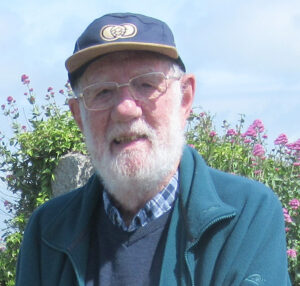 John Buckingham (Bardh Kernow – Spiser Jowan)
John Buckingham (Bardh Kernow – Spiser Jowan)
Living in Padstow and loving the stories I have learned from my life here has given me the encouragement to write about some of them. Thanks to my wife, Liz, for her patience and invaluable help with grammar and punctuation.
Thanks too, to my friends past and present in Padstow Museum and the Old Cornwall Society and to the opportunity given to contribute to the Padstow Echo over a period of many years. Thanks also to Tony Mansell for help with this article. This is my best shot at one of them.
